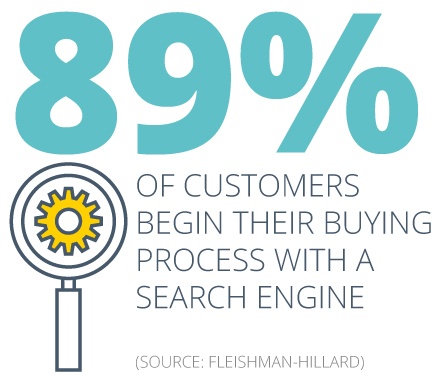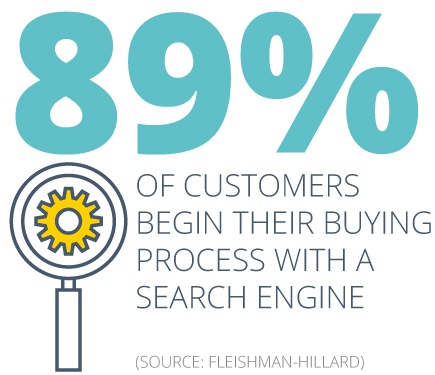89% of customers begin their buying process with a search engine
September 6, 2017

 It has happened to all of us – those nuisance calls attempting to sell double glazing or accident insurance. Well luckily, this type of marketing is falling out of favour, being replaced by something much more customer oriented.
It has happened to all of us – those nuisance calls attempting to sell double glazing or accident insurance. Well luckily, this type of marketing is falling out of favour, being replaced by something much more customer oriented.
Inbound Marketing
The way that successful marketing operates has changed. Instead of companies suggesting a product to potential buyers, customers now use the internet to search for the products and services that they want, even before considering a purchase. 81% of shoppers conduct online research before buying, so that means that your company needs to:
- Appear at the top of the search list
- Attract the visitor with a well-designed website
- Inform the visitor about the company and its products and services through compelling Content
- Convert the visitor into a customer
- Delight the customer after a deal has been closed
This process is part of inbound marketing, which aims to allow the customer to find the company, rather than the other way around.
Consumers are Changing
Buyers are getting younger, with many using a variety of mobile devices to quickly search for what they want, making snap decisions about whether your website offers the solutions they need. This means that your website needs to grab the customer’s attention in a short space of time and be easy to navigate. A key factor governing what keeps a visitor on a site is professional and attractive looking design, as the majority of internet users will initially judge a company’s credibility by the look of their website.
Responsive Design
Websites that have been designed to respond to different screen sizes, shifting to fit into the space or be more easily navigable on a mobile device are termed ‘responsive’. Many companies are still slow to catch on to the idea of responsive web design, so an accessible website means that you have a greater opportunity to be seen by buyers using mobile phones and tablets to browse the internet. This offers an advantage in a competitive online marketplace. Sites without responsive design often do not make the list of top sites after a keyword search, so you will have an automatic head-start if you make your website compatible with a range of devices.
Compelling Content
Once the customer’s interest has been piqued, it is the content that will entice them to stay on your website and bring them further into the buyer’s journey. Simple and informative content will persuade the customer that your company is right for them. However, it is important that content includes prompts for the customer, allowing them to access further products and services through clickable links and buttons. The buyer will want be assured that your products and services are of a high quality, so it is likely that they will conduct further research, checking ‘about us’ articles, social media accounts and customer reviews.
Follow-up is Key
It is a misconception that if the deal is closed, then the buyer process is over. Savvy companies will understand that retaining a customer relies on continually surprising and delighting them with more content and offers. Custom should be followed up with thank you pages, welcome emails and further information about the company. Buyers will be more likely to purchase again if they feel they are valued and undergo a personal and engaging experience, so follow-up after a lead has been converted into a customer is key.
Companies that keep abreast of how the consumer process is changing will have a better chance of being part of the hunt, with the difference being that the customer is no longer the prey.
Comments